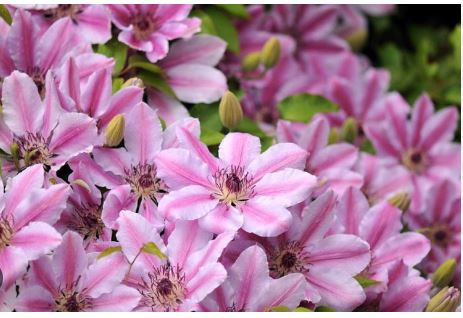
Clematis ‘Nelly Moser’ is one of the most famous and enduringly popular clematis cultivars. It was bred by Moser in France in 1897. This hybrid was named after the wife or daughter of the breeder, which was a common practice at the time. ‘Nelly Moser’ quickly became favored for its unique and large flowers, making it a staple in gardens worldwide.
Characteristics
- Flowers: ‘Nelly Moser’ is known for its large, star-shaped flowers, which can be up to 8 inches (20 cm) in diameter. Each flower has eight sepals (often mistaken for petals), which are pale mauve-pink with a distinctive deeper pink or reddish-purple stripe down the center of each sepal. The contrast creates a striking ‘bar’ effect.
- Growth Habit: This clematis is moderately vigorous, growing to about 8 to 10 feet (2.5 to 3 meters). It’s ideal for climbing up trellises, arbors, or along fences.
- Bloom Time: It blooms profusely in late spring to early summer, with a possible second, less profuse flowering in late summer or early fall.
- Foliage: The leaves are green, often with a slightly serrated edge, providing a lush backdrop to the flowers.
- Pruning Group: ‘Nelly Moser’ belongs to Pruning Group 2, which means it benefits from light pruning. Prune in late winter or early spring to remove dead or weak stems, and then again after the first flush of blooms to encourage a second flowering.
Cultivation
- Sunlight: Prefers a position where its roots are shaded but the upper plant gets full sun to part shade. This helps in producing more vibrant flowers while keeping the roots cool.
- Soil: Thrives in well-drained, fertile soil rich in organic matter. Like most clematis, it prefers a neutral to slightly alkaline pH.
- Watering: Needs regular watering, especially in dry periods, to keep the soil consistently moist but not waterlogged.
- Planting: Plant ‘Nelly Moser’ so that the base of the plant is about 2-3 inches below the soil surface. This encourages more shoots to grow from the base, making the plant fuller.
- Support: Provide a sturdy structure for it to climb. Training the vines early on can help in achieving the desired coverage.
- Mulching: Mulch around the base to retain moisture, keep roots cool, and minimize weed competition.
- Fertilization: Feed with a balanced fertilizer in early spring and again in summer after the first bloom to promote reblooming.
- Diseases: Like all clematis, ‘Nelly Moser’ can be susceptible to clematis wilt. Planting deeply, ensuring good air circulation, and choosing a healthy specimen can reduce this risk.
- Winter Care: In colder climates, while ‘Nelly Moser’ is quite hardy, providing some protection or heavy mulching around the base can be beneficial after pruning.